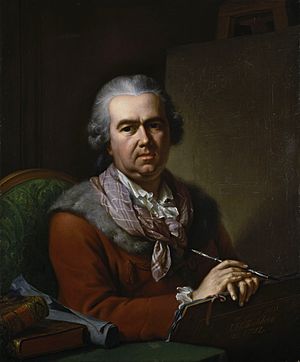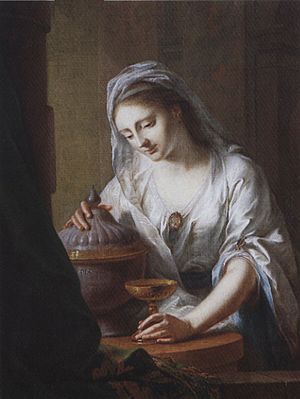Johann Heinrich Tischbein facts for kids
Johann Heinrich Tischbein the Elder (born October 3, 1722, died August 22, 1789) was a very famous German painter from the 1700s. He was known as the Kasseler Tischbein because he lived in Kassel. He was part of a large family of artists called the Tischbein family, which had painters for three generations!
He mostly painted pictures of important people (like kings and queens), scenes from old myths (stories about gods and heroes), and historical events. When he painted mythological scenes, the people in his paintings were often from noble families.
Life
Johann Heinrich Tischbein's father, Johann Tischbein, was a baker. Five of his eight children became painters, showing how artistic their family was! From 1736 to 1741, Johann Heinrich learned how to paint wallpaper. Later, he studied oil painting with Johann Georg von Freese.
After his studies, he worked for small royal families. In 1743, a kind sponsor named Count Johann Philipp von Stadion helped him. This allowed Johann Heinrich to travel to Paris and study painting with Carle van Loo.
In 1749, he went to Venice to learn from Giovanni Battista Piazzetta. He then spent a year in Rome, learning even more. In 1753, he became the official court painter for William VIII, Landgrave of Hesse-Kassel. This meant he painted portraits and helped decorate places like Schloss Wilhelmsthal.
During the Seven Years' War, he had to leave Kassel to escape the French army. He lived in different places until the war ended in 1762. When he returned, he became a professor at the new Collegium Carolinum in Kassel.
When he wasn't teaching, he often visited Schloss Warthausen. This was an estate owned by his old sponsor, Count Stadion. He also spent time in Hamburg because he was friends with the writer Friedrich Gottlieb Klopstock. Johann Heinrich Tischbein was married twice and had two daughters with his first wife.
Works
Johann Heinrich Tischbein created many important paintings. Some of his famous works include:
- Resurrection (1763): An altarpiece for the St. Michaelis Church, Hamburg. Sadly, it burned down in 1906.
- Transfiguration (1765): Found in the Lutherische Kirche in Kassel.
- Passion and Ascension cycle (1778): These paintings were for the St. Elisabeth Catholic Church in Kassel. You can now see them in the Cathedral Museum Fulda.
- Kreuzabnahme and Himmelfahrt (1787): Altarpieces for the Jakobikirche in Stralsund.
- Christ on the Mount of Olives (1788): Located in the former Cistercian Monastery in Haina.
- Allegory on the Founding of the Kasseler Akademie
- Hercules and Omphale
- May Day at Gut Freienhagen
Portraits
He was especially well-known for his portraits. Some of his notable portraits include:
- A self-portrait with his first wife.
- The actress Evérard.
- The poet Philippine Engelhard (who was born Gatterer).
- Landgraf Friederick II.
- Princess Christine Charlotte of Hesse-Kassel.
See also
 In Spanish: Johann Heinrich Tischbein para niños
In Spanish: Johann Heinrich Tischbein para niños



